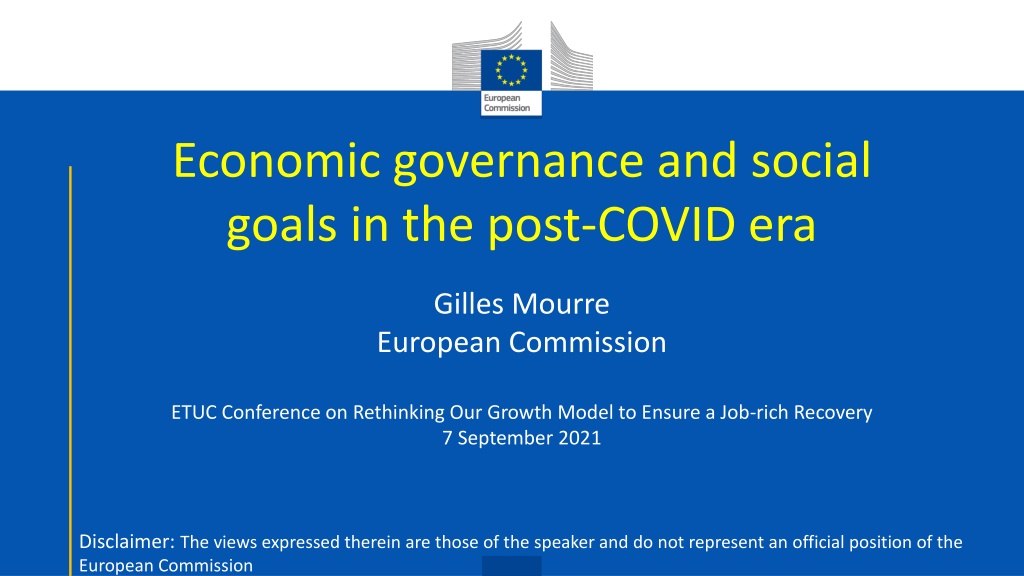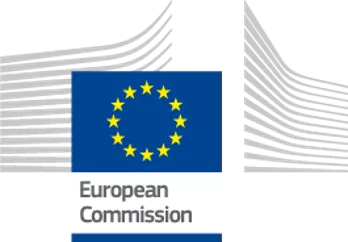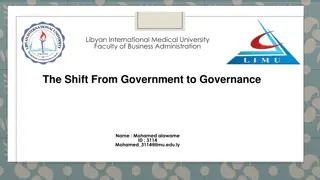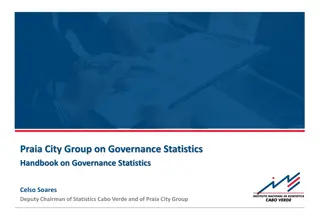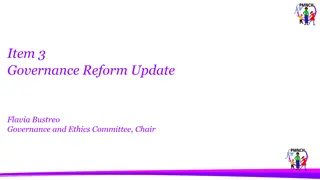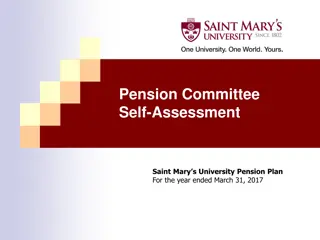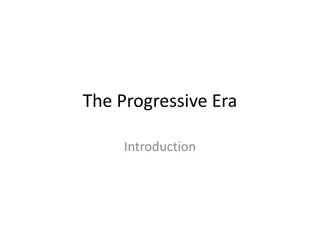Economic Governance and Social Goals in the Post-COVID Era: A Review by Gilles Mourre
Explore the economic governance framework in the aftermath of COVID-19, focusing on implications, social goals, and the need for regular reviews. Key findings from the pre-COVID review highlight complexities, budgetary positions, public debt levels, and the composition of fiscal policies.
Download Presentation

Please find below an Image/Link to download the presentation.
The content on the website is provided AS IS for your information and personal use only. It may not be sold, licensed, or shared on other websites without obtaining consent from the author. Download presentation by click this link. If you encounter any issues during the download, it is possible that the publisher has removed the file from their server.
E N D
Presentation Transcript
Economic governance and social goals in the post-COVID era Gilles Mourre European Commission ETUC Conference on Rethinking Our Growth Model to Ensure a Job-rich Recovery 7 September 2021 Disclaimer: The views expressed therein are those of the speaker and do not represent an official position of the European Commission
Outline 1. Review of the economic governance framework 2. Implications of the COVID-19 crisis 3. Economic governance and social goals 2
Economic governance framework: what for? What? A rulebook designed to ensure that Member States pursue sound public finances and coordinate their fiscal policies Why? The economic and monetary union is an unprecedented entity Centralized monetary policy (ECB) + decentralised fiscal policy (Member States) risks of a monetary bail-out, negative spillovers to other Member States Fiscal rules help prevent sovereign debt crises, which are very damaging for social equality, especially in vulnerable countries with no fiscal space fiscal rules are a condition for social equity 3
Regular reviews required by law The legislation requires the Commission to conduct a regular review of the economic governance framework every 5 years The Commission published its most recent review in February 2020 and launched a public debate on the next steps With the outbreak of the pandemic in March 2020, the public consultation was put on hold The debate with all stakeholders, including trade unions, will be relaunched when the recovery takes place 4
Key findings of the pre-COVID review The framework has become overly complex, hampering transparency, ownership and enforceability A majority of EU countries have managed to reach a sound budgetary position, reducing their debt and rebuilding buffer before the crisis. However, public debt has remained at a very high level in a number of Member States (without significant reductions before the pandemic) Fiscal policies had been often pro-cyclical The composition of public finances had not become more growth- and investment-friendly 5
Building blocks of the relaunched review Main conclusions from the 2020 review: still relevant, even more pressing than before the pandemic Lessons from the COVID-19 crisis and reflections on how to ensure a sustainable recovery Related: when to exit the emergency mode and deactivate the general escape clause? Discussion on the policy mix and the role of fiscal policy in times of persistent low interest rates 6
Outline 1. Review of the economic governance framework 2. Implications of the COVID-19 crisis a) Fostering economic stabilisation b) Ensuring debt sustainability c) Promoting the quality of public finance 3. Economic governance and social goals 7
Unprecedented crisis, unprecedented fiscal response Macroeconomic impact of the global financial crisis and the COVID-19 crisis on the EU economy (2009 and 2020; year-on-year change, %) Public finance impact of the global financial crisis and the COVID-19 crisis in the EU (2009 and 2020; year-on-year change, pps. of GDP) Global financial crisis COVID-19 crisis Global financial crisis COVID-19 crisis 0 Headline deficit -4 -8 Public debt -12 Real GDP Private consumption Investment 0 5 10 15 8 Source: European Commission 2021 spring forecast.
Unprecedented EU-level support, funded by EU debt issuance Increase in unemployment rate in SURE beneficiary Member States, 2020 (pps.) Temporary Unemployment Risks in an Emergency (SURE): 100 billion Support to mitigate Cheap loans have helped Member States to implement short-time work schemes, preserving employment Expected Supported 30 million people ( of employment in beneficiary Member States) PREVENTED Actual Recovery and Resilience Facility: 672.5 billion 0 1 2 3 4 Grants and loans for investment and reforms to mitigate the economic and Note: The expected increase in the unemployment rate reflects the historic relationship between changes in unemployment rate and negative GDP growth. Source: European Commission. 9
A mutually-reinforcing policy mix supported the recovery, unlike during the global financial crisis Policy mix during the global financial crisis and the COVID-19 crisis in the euro area (%) bps. pps. Expansionary (Easing) 2.0 -1.00 1.5 -0.75 1.0 -0.50 0.5 -0.25 0.0 0.00 Contractionary (Tightening) -0.5 0.25 2008 2009 2010 2020 2021 2022 Fiscal stance Monetary stance (right scale) 10 Note: Monetary stance is measured by the change in the real long-term interest rate. Source: European Commission 2021 spring forecast.
Implications for the future: Economic stabilisation The pandemic has highlighted the positive role that countercyclicaldiscretionary fiscal policy and European coordination can play in responding to crises and downturns How can national fiscal policy respond to economic fluctuations while complying with the EU fiscal rules and restoring necessary buffers? Using the EU tools introduced during the crisis (RRF) efficiently to support the recovery and long-term growth 11 Need to monitor and address macroeconomic imbalances
Outline 1. Review of the economic governance framework 2. Implications of the COVID-19 crisis a) Fostering economic stabilisation b) Ensuring debt sustainability c) Promoting the quality of public finance 3. Economic governance and social goals 12
Public debt soared, sustainability risks increased Public debt in the EU, 2006-2031 (% of GDP) Medium-term debt sustainability risks in the EU (% of all Member States) 100 100 75 90 50 80 25 70 0 60 Pre-crisis assessment Not assessed Latest assessment Medium 2006 2011 2016 2021 2026 2031 Low High Note: Projections (shaded bars) assume a gradual return of structural primary balances to pre-crisis forecast values for 2021. Source: European Commission. Note: No risk classification for Greece in 2019. Source: European Commission. 13
Should we worry about high public debt? Higher debt is less costly when the interest-growth differential is negative But strong reasons to keep debt sustainable: Negative interest-growth differential forever? Market perception of sustainability risks may also change, increasing risk premia Public debt is due to increase: population ageing high contingent liability (guarantees provided by government) Wise to have buffers for future crises and fiscal space for green and digital transformation May reduce welfare of future generations if debt does not finance the increase of productive investment (intergenerational equity) 14
Implications for the future: Ensuring debt sustainability How to reduce high public debt ratios in a sustainable, growth- friendly manner? Numeric rules vs principles: the issue of implementability Role of debt sustainability analysis Compliance with the debt reduction benchmark in its current form? What should be the role of national fiscal framework and national independent fiscal institutions? 15
Outline 1. Review of the economic governance framework 2. Implications of the COVID-19 crisis a) Fostering economic stabilisation b) Ensuring debt sustainability c) Promoting the quality of public finance 3. Economic governance and social goals 16
Chronic under-investment pre-COVID and the RRF Public investment in the EU, 2006-2022 (% of GDP) EU: Costs financed by RRF grants, 2020-2026 (% of total costs) 4.0 RRF-financed 3.5 3.0 2.5 2.0 2006 2010 2014 2018 2022 Public investment Current spending Private investment Revenue measures 17 Note: Belgium, Luxembourg, Netherlands, Poland and Sweden are not included. Source: 2021 SCPs. Source: European Commission.
Implications for the future: Promoting the quality of public finance How should fiscal policy support the green and digital transitions? How to incentivise adequate public investment? Does green investment deserve special treatment? 18
Outline 1. Review of the economic governance framework 2. Implications of the COVID-19 crisis a) Fostering economic stabilisation b) Ensuring debt sustainability c) Promoting the quality of public finance 3. Economic governance and social goals 19
Economic governance and social goals The Commission is integrating the Sustainable Development Goals in relevant economic governance processes such as the European Semester Effective implementation of Next Generation EU should deliver 2% of additional GDP by 2024 and create 2 million jobs The Recovery and Resilience Facility (RRF) will support building a more sustainable, resilient and fairer Europe for the next generation in line with the Sustainable Development Goals 20
Thank you 21
Review: Questions for public discussion (1) Rebuilding trust and consensus on the policy goals: How to better ensure sustainable public finances and tackle macroeconomic imbalances? How to avoid pro-cyclicality? How to support growth-friendly public finances and incentivise reforms and investment to tackle economic, social and environmental challenges? How to take into account euro area dimension and EMU deepening? 22
Review: Questions for public discussion (2) How to achieve the policy goals: How to make the framework simpler and more transparent? How to make the framework more focused on gross errors ? How to ensure effective enforcement? What role for national frameworks and how to improve interaction with EU rules? How can the SGP and MIP work better together? 23 Back
